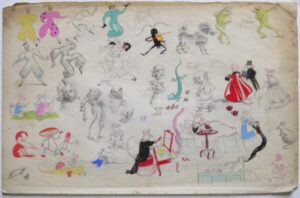Pares, Ethel “Bip” (1904-1977)
Ethel “Bip” Pares was born on 27th February 1904 in the Thames-side village of Clewer, just beyond Windsor. She was the second child of the marriage of Basil Pares (1869-1943) and his wife Caroline Evelyn Whistler (1874-1959), who had married in Norfolk in 1902. Her father was a younger son of the well-to-do family of John and Katharine Pares. A Lancing and Cambridge (Emmanuel) man, Basil Pares became a surgeon, served as a civilian in the South African wars of 1899-1901, and then transferred to the army, becoming Surgeon-Major of the Royal Horse Guards in 1906. He served in the Great War, picking up a DSO in 1915 and a CMG in 1916, and was mentioned twice in despatches.
Ethel Pares had been named after an aunt, but her pet family name of Bip (apparently deriving from her infant attempts at pronouncing the name of a family horse) became the one which she used professionally and even quite frequently on official records and documents. She studied at the Slade School of Art in the early twenties and took to a career as a commercial artist, producing illustrations and posters. She illustrated some 18 books and was also a prolific book jacket designer, working in this field from the 1920s to at least the late 1950s. It has been calculated that Pares designed in excess of 600 book jackets by 1939 alone. She produced two posters for London Underground and during the 1920s and 1930s designed advertising showcards. During World War Two, Pares drew campaign maps for the ‘Daily Express’ newspaper. Some of her best work appeared on the covers of sci-fi novels, such as E Phillips Oppenheim's The Dumb Gods Speak (1937) and the same author's Mr Mirakel (1943), both Near Future tales involving Inventions; her work featured on quite a number of Oppenheim's non-sci-fi novels, too. She did covers for an impressive array of other crime-fiction writers, including several for Michael Gilbert. Among further authors to receive a plurality of Pares covers was James Hilton; for Goodbye Mr Chips (1934) she did not only the cover but interior Illustrations. Far more central to the genre were her covers for Olaf Stapledon's Star Maker (1937), for Susan Ertz's Woman Alive (1935) – for which she also did interiors – and for Francis Gerard's Secret Sceptre (1937). The best of her cover Illustrations are strikingly beautiful; many have an Art Deco sensibility. Her skill in the use of colour was striking, whether muted or bold.
In 1932 she was living with flatmates at 9a Hampstead High Street, next door to the old King of Bohemia public house. On 30th September 1933, at the age of twenty-nine, she married Alfred Trevor Gwyn Thomas, a medical man like her father, then attached to St. Mary Abbot’s Hospital in Kensington. A few months her junior, he was the Newcastle-born son of a Welsh clergyman. The marriage took place at Horsell, near Woking, in Surrey – the service conducted by her uncle, Norman Pares, who was the vicar. The marriage did not last long. Her husband appeared just once on the electoral register at 9a Hampstead High Street – in 1934. In 1936 she petitioned for divorce. Her husband is last heard of sailing for Mombasa in 1946. New flatmates at this time included Eric Vernon Francis, writer on politics and economics, and Frederick Elwyn Jones, later Baron Elwyn-Jones, the Welsh barrister and Labour politician. Bip Pares’ second marriage took place at Hampstead in 1938. Her new husband was Robert Christopher Bradby (1905-1982), son of Henry Christopher Bradby (1868-1947), master at Rugby School and a minor poet. The honeymoon was spent exotically in the Himalayas, taking advantage of the opportunity afforded to travel with the British Everest Expedition which set out that year under Bill Tilman. Her own account of the journey was published by Hodder & Stoughton in 1940 as “Himalayan Honeymoon”, complete – of course – with her own illustrations. On their return, the couple settled at 20 Frognal Lane, Hampstead. Her husband served in the war, gazetted second-lieutenant in 1940. By 1948 this marriage too had broken down and they were living apart. Bip Pares moved to 18 Hollycroft Avenue, Hampstead, where she remained until at least 1965, and probably for the rest of her life. Her death aged seventy-three was registered in Hampstead in 1977. Her final years are said to have been plagued by ill-health.
Showing the single result
